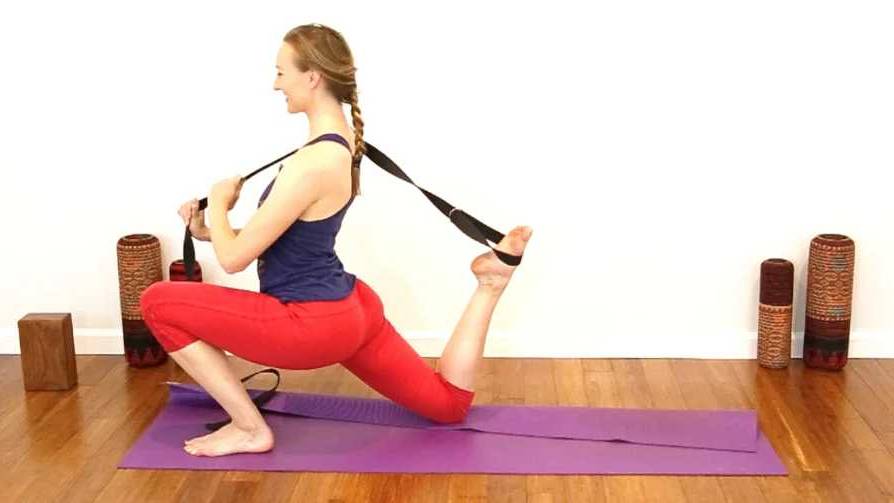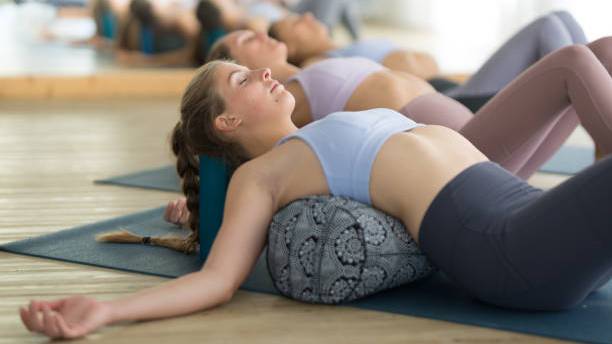Yoga props like mats, blocks, straps, and bolsters make your practice easier and safer. They help you stretch more comfortably, stay balanced, and keep your body aligned, so you can enjoy yoga without strain.
✅ Can Using Yoga Props Really Cause Injuries?
Using yoga props is generally safe and is intended to reduce the risk of injury by providing support, improving alignment, and making poses more accessible. However, like any tool, props can cause injury if used incorrectly. For example:
- Improper positioning: Placing a block, strap, or bolster in the wrong spot can throw off alignment, putting unnecessary strain on joints, muscles, or the spine.
- Excessive force: Forcing a stretch with a strap or pushing too hard on a yoga block can lead to muscle strains or joint discomfort.
- Worn or unstable props: Old mats, cracked blocks, or slippery blankets may not provide proper support, increasing the risk of slipping or imbalance.
To avoid injuries, it's important to:
- Learn proper use of each prop, ideally with guidance from a qualified instructor.
- Use props that are in good condition, stable, and appropriate for your body size and strength.
- Listen to your body—props should aid your practice, not push you beyond your limits.
When used correctly, yoga props enhance safety, comfort, and effectiveness, allowing practitioners of all levels to explore poses confidently and prevent strain or injury.
✅ How You Use Yoga Props?
Using yoga props effectively involves understanding their purpose and learning how to integrate them into your practice safely and mindfully. Each prop serves a unique role, whether it's to provide support, improve alignment, increase flexibility, or enhance comfort during poses. Here's a detailed guide on how to use common yoga props:
Yoga Mats
The mat is the foundation of your practice. Place it on a flat surface to ensure stability and traction. A yoga mat cushions your joints, protects against slipping, and defines your personal practice space. For people with sensitive knees or wrists, thicker mats can provide extra comfort, while thinner mats offer better balance for standing poses.


Yoga Straps
Straps help extend your reach and assist in deepening stretches safely. Loop the yoga strap around your feet, hands, or legs to maintain proper alignment without overextending. For example, in seated forward bends or hamstring stretches, a strap allows you to hold your feet comfortably and gradually increase flexibility. Straps also help maintain form in poses that require flexibility you're still developing.
Yoga Blocks (Bricks)
Blocks provide height, stability, and support. Place them under your hands, feet, or hips to help maintain proper alignment and balance. They are particularly useful in standing poses, such as Triangle or Half Moon, where they prevent overreaching and improve posture. Yoga Blocks can also be stacked or folded to adjust height, making poses more accessible or challenging depending on your practice goals.


Yoga Bolsters
Bolsters support the body in restorative poses, helping to maintain correct posture and reduce strain on muscles and joints. They can be placed under the spine, knees, or hips to open the chest, relieve lower back pressure, or support long-held stretches. Yoga bolsters are essential in yin and restorative yoga, where relaxation and breath awareness are emphasized.
Yoga Balls
Yoga balls are efficient and low-threshold fitness tools suitable for people of all ages. By rationally the size of the yoga ball, controlling the inflation volume and combining it with scientific movement design, a comprehensive improvement in strength, flexibility and balance can be achieved.


Yoga Rollers
The yoga roller (also known as the yoga wheel) is a round and hollow yoga auxiliary tool, with a diameter usually ranging from 25 to 35 centimeters and a thickness of about 10 to 15 centimeters. The design of the yoga roller breaks through the sharp corners of traditional yoga bricks and perfectly conforms to the curve of the human spine.
We are committed to delivering exceptional support and
top-tier service whenever you need it!
✅ Yoga Props Are All Around Us
Yoga props are more common than many people realize—they aren't limited to specialized equipment sold in stores. Everyday items around your home can often serve as effective substitutes, making yoga more accessible and adaptable.
For example, a sturdy chair can be used for support in standing poses or seated stretches, while a thick towel or folded blanket can act as a bolster for restorative poses. Books or small cushions can function as blocks to help maintain alignment, and even a belt or scarf can be used as a strap to extend your reach in forward bends or leg stretches.
Using household items as props allows you to practice yoga safely and comfortably without needing a full set of traditional equipment. It also encourages creativity and mindfulness, as you learn to adapt your environment to support your body and movements. By recognizing that props are all around us, you can make your practice more flexible, accessible, and enjoyable—anytime, anywhere.
✅ The Yoga Props Within Us
The yoga props within us refer to the idea that our own body and breath can act as natural supports during practice. While external props like mats, blocks, and straps are helpful, our muscles, bones, and mindful breathing can serve as tools to enhance alignment, stability, and flexibility.
For instance, engaging your core can act like a built-in bolster, supporting your spine in seated or balancing poses. Activating leg and arm muscles can provide the stability that a block or wall might otherwise offer. Breath control can deepen stretches, release tension, and help you maintain poses longer, much like an external strap or cushion would.
By cultivating awareness of these internal “props,” practitioners learn to rely on their body's own strength and coordination. This not only makes yoga more adaptable in situations where external props aren't available but also deepens mind-body connection, helping you move safely, efficiently, and with greater confidence.
✅ Conclusion
Whether you are a beginner or an experienced yogi, yoga props offer invaluable support for your body and practice. They help you maintain proper alignment, increase flexibility, build strength, and hold poses longer with comfort and safety. By using props thoughtfully, you can enhance your yoga journey, making every session more effective, enjoyable, and accessible.

Talk To Our Experts
Connect with an NQ expert to discuss your product needs
and get started on your project.
✅ FAQs About Yoga Props
What are yoga props and why should I use them?
Yoga props are tools such as mats, blocks, straps, bolsters, blankets, and chairs designed to support your practice. They help improve alignment, increase comfort, deepen stretches, and make poses more accessible. Props are useful for beginners, experienced practitioners, and anyone with limited flexibility or mobility.
Which yoga props should beginners start with?
Beginners typically benefit most from a non-slip yoga mat, a pair of yoga blocks, and a yoga strap. A mat provides cushioning and grip, blocks help bring the floor closer for proper alignment, and straps extend your reach in stretches, allowing you to practice safely and gradually improve flexibility.
How do I choose the right yoga mat?
Consider thickness, texture, material, and portability. A mat around 4–6mm thick balances cushioning and stability, while a textured surface prevents slipping. Materials like natural rubber, TPE, or PVC have different levels of durability, grip, and eco-friendliness. A mat should feel comfortable under your joints and be easy to clean and carry.
What are yoga blocks used for?
Blocks are used to support your hands, feet, or hips in standing, seated, and floor poses. They help maintain proper alignment, deepen stretches safely, and can even increase the challenge in balancing or strength-focused poses. Blocks can be made of foam, cork, or wood, each offering different levels of firmness and stability.
What is the purpose of yoga bolsters?
Bolsters provide support and comfort, particularly in restorative and prenatal yoga. They can be placed under the back, knees, or hips to maintain proper posture, relieve pressure, and allow for longer holds. Bolsters help open the chest, support the spine, and enhance relaxation during meditation or restorative poses.
Post time: Nov-13-2025
